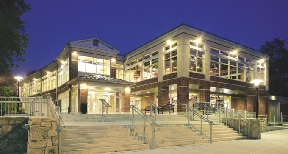The University of Rhode Island's newest dining facility, Hope Commons, has been awarded LEED Silver certification by the U.S. Green Building Council (USGBC). LEED is the USGBC's rating system for designing and constructing the world's greenest, most energy efficient, and highest performing buildings.
"URI and Vision 3 Architects are to be commended for achieving LEED Silver certification," said Rick Fedrizzi, president, CEO, founding chair, USGBC. "Hope Commons will be a showcase for high-performance, energy-efficient, healthy construction, and an inspiration for others."
Opened in August 2007, Hope Commons is an $18 million construction, 42,500 s/f dining facility featuring a 600-seat dining hall, 110-seat late night café, and a convenience market. Hope Commons is the first new, free standing dining facility on campus in 45 years and replaces two dining facilities; the original Hope Dining Hall, which was built in 1957, and Roger Williams Dining Hall.
The LEED rating system was established by the USGBC for market leaders to design and construct buildings that protect and save precious resources while also making good economic sense.
"We are honored to have been involved in such a project as Hope Commons," said Paul Castellone, AIA, LEED AP, associate of Vision 3.
LEED certification of Hope Commons was based on the USGBC's verification of a number of sustainable design and construction features that positively impact the project and the broader community, including:
* Installation of a reflective roof coating to prevent heat absorption and reduce cost to cool the building.
* Specification of energy efficient lighting, and incorporation of design strategies to take advantage of daylight and reduce interior illumination requirements. The quality of the work environment life for kitchen staff is significantly improved with natural light and outside views.
* Selection of exterior lighting to only illuminate pathways and specific areas, thereby reducing "light pollution".
* Elimination of landscape irrigation systems by selection of native, drought resistant plantings.
* Successful diversion from landfills of 94% of demolition materials from the razed Hope Dining Hall.
* Achievement of 26.5% recycled content in construction materials used for the project.
* 75% of construction materials used in the project come from local and regional sources within 500 miles of the project, thereby significantly reducing energy and cost for transportation.
* Water saving plumbing fixtures and kitchen equipment were installed throughout, and result in saving of over 55,000 gallons of water per year.
"Food service equipment uses a great deal of energy - especially dishwashing machines - so it is particularly challenging to build and equip a dining hall to meet LEED certification requirements," said Paul DePace, URI director of capital projects.
Tags:
Vision 3 Archts.' design of Hope Commons at URI awarded LEED Silver certification
October 09, 2008 - Rhode Island









